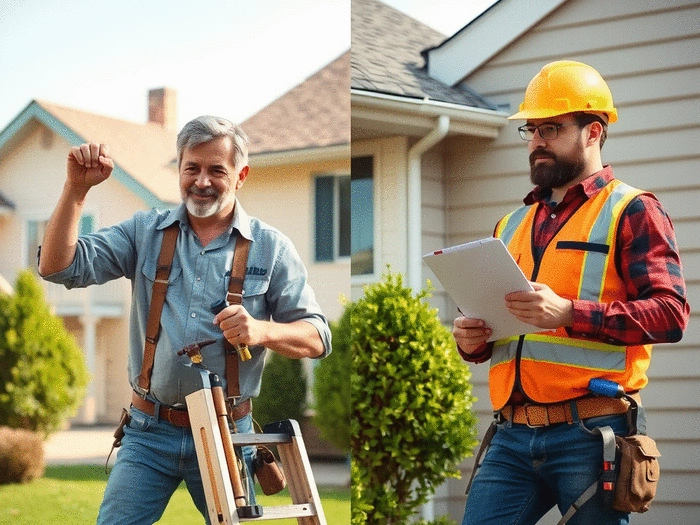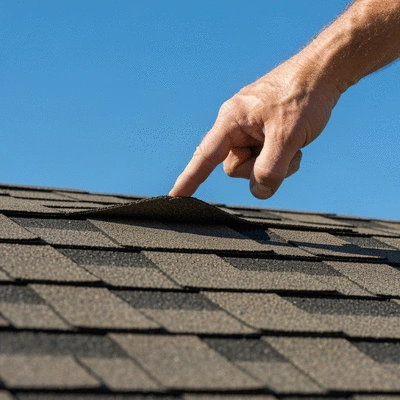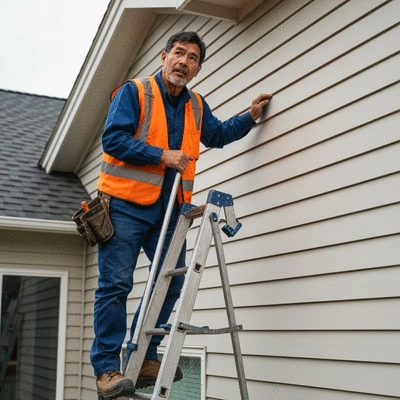DIY or Hire for Repairs?

Posted on: 2025-10-30
By: Samuel T. Masters
Have you ever stared at a small leak in your roof, wondering if it’s worth tackling yourself or better left to a professional? Understanding roofing and siding repairs not only protects your investment but also enhances your home's overall value.
What You Will Learn
- Identify different types of damage and know when to consider repairs.
- Weigh the costs of DIY projects against hiring professionals.
- Recognize safety as a priority when undertaking home repairs.
- Assess your own skills honestly before attempting repairs yourself.
- Know when to reach out to a professional contractor for assistance.
Comparing Roofing & Siding Repair Costs and Damage Types
This visual compares the anticipated repair costs for various roofing and siding materials with common damage types, highlighting the distinction between DIY-friendly minor issues and professionally handled complex problems.
Anticipated Repair Costs (per square)
Costs vary by material and labor. Professional quality ensures long-term savings.
Types of Damage: DIY vs. Professional
Early detection and appropriate action prevent costlier problems.
Understanding Roofing and Siding Repairs: Key Considerations
When it comes to maintaining your home, roofing and siding repairs are crucial aspects that shouldn't be overlooked. Identifying the types of damage early can save you a lot of trouble down the line. From minor issues like loose shingles to complex problems like significant water damage, understanding what’s at stake can help you make informed decisions. Have you noticed any cracks, leaks, or discoloration? These common signs often indicate that it’s time for some repairs!
As a homeowner in Memphis, I’ve seen it all in my 25 years in this business. It's vital to differentiate between minor repairs, which you might tackle yourself, and more complex issues that may require professional help. Addressing these problems sooner rather than later can prevent larger, more costly issues from arising. For homeowners considering DIY projects, resources like the AHRQ's DIY Safety Guide offer essential safety tips, emphasizing that safety should always be a priority when undertaking home repairs.

Identifying the Types of Damage: When to Consider Repairs
- Minor Damage: Loose or missing shingles
- Moderate Damage: Small leaks or cracks in siding
- Complex Damage: Water damage or structural issues
- Signs to Watch For: Mold growth and peeling paint
As you assess your roofing and siding, look for these signs. Minor damage is often easy to fix with a few tools and some time, but if you notice structural issues or widespread damage, it’s time to call in the professionals. For those interested in improving their home's energy efficiency through DIY projects, the EPA provides valuable insights on various upgrades that can be done yourself. Remember, preventive maintenance can go a long way in extending the life of your home’s exterior!
Cost Insights: DIY vs. Professional Roofing and Siding Repairs
Now, let’s talk about costs. Understanding the financial implications of DIY versus hiring a professional can significantly influence your decision-making process. For DIY projects, you’ll need to consider not just the cost of materials, but also the tools you’ll require. These can add up quickly! At Myles Properties, we often find that while DIY may seem cheaper upfront, it can lead to higher expenses if mistakes are made.
- DIY Costs: Materials, tools, and time investment
- Professional Costs: Labor, expertise, and warranty
- Potential Long-Term Savings: Quality workmanship can reduce future repairs
Choosing a professional might feel like a bigger investment, but with the right contractor, like Myles Properties, you’ll receive quality workmanship that can save you money in the long run. The Joint Center for Housing Studies of Harvard University offers insightful research on the remodeling industry, highlighting how professional repairs contribute to long-term home value. It’s all about weighing the options and considering what’s best for your home!

Repair Costs: What Homeowners Should Anticipate
Understanding the cost of repairs is vital for any homeowner. Depending on the materials used, repair costs can vary widely. For instance, asphalt shingles might be less expensive to repair compared to metal roofing, which can demand a higher price due to labor and material costs. Typically, you can expect to budget for both labor and materials when planning your repairs.
- Asphalt Shingles: $150 - $400 per square
- Wood Siding: $300 - $800 per square
- Vinyl Siding: $200 - $400 per square
- Metal Roofing: $300 - $700 per square
By having a good grasp of these figures, you can better anticipate what your budget will need to cover. Always remember, investing in quality repairs today can prevent costly issues tomorrow, so don’t hesitate to reach out for an estimate if you're unsure!
Pro Tip
Did you know? Regular inspections can save you thousands in roofing and siding repairs. Aim to inspect your home's exterior at least twice a year, focusing on areas prone to damage like corners and eaves. Early detection of minor issues can prevent them from escalating into costly repairs!
Frequently Asked Questions About Roofing and Siding Repairs
- Q: What are the common signs that my roof or siding needs repair?
- A: Common signs include loose or missing shingles, small leaks, cracks in siding, peeling paint, discolored areas, and visible mold growth. Early detection of these issues can prevent more extensive damage.
- Q: When should I consider a DIY repair versus hiring a professional?
- A: Minor issues like a few loose shingles or small cracks in siding can often be handled as DIY projects. However, for significant water damage, structural issues, widespread damage, or any safety concerns, it is always recommended to hire a professional contractor.
- Q: What are the typical costs for roofing and siding repairs?
- A: Repair costs vary significantly by material and the extent of the damage. For example, asphalt shingle repairs can range from $150-$400 per square, while metal roofing might be $300-$700 per square. These costs include both materials and labor.
- Q: How can I save money on roofing and siding repairs in the long run?
- A: Regular inspections and preventative maintenance are key. Addressing minor issues promptly can prevent them from escalating into more costly problems. Investing in quality professional repairs also ensures durability and reduces the frequency of future repairs.
- Q: What safety precautions should I take if I attempt a DIY repair?
- A: Always prioritize safety. Ensure you have the right safety gear, including harnesses for roof work, sturdy ladders, and protective eyewear. Never work alone, especially on roofs, and be aware of weather conditions. If you feel uncomfortable or the repair seems too complex, it's safer to call a professional.
Wrapping Up: Your Roadmap to Roofing and Siding Repairs
As we come to the end of our guide on roofing and siding repairs, let’s take a moment to recap the key takeaways for homeowners like you. Understanding the types of damage, safety considerations, and the financial aspects of repair work is crucial. Whether you're contemplating a DIY project or considering hiring a professional, informed decision-making will help ensure that your home remains safe and secure.
Remember, the right approach to repairs not only protects your investment but also enhances the overall functionality and value of your home. With the right knowledge, you can confidently navigate these important home maintenance issues.
Summarizing Key Takeaways for Homeowners
- Identify the type of damage before deciding on repairs.
- Understand the costs involved in DIY versus professional work.
- Always prioritize safety when considering home repairs.
- Assess your skills honestly before attempting repairs yourself.
- Know when to reach out to a professional contractor for help.
Each of these points contributes to a more effective repair process. By keeping them in mind, you can approach your roofing and siding needs with confidence.
Next Steps: Moving Forward with Confidence
Now that you have a better understanding of roofing and siding repairs, it’s time to assess your own situation. Are there repairs you feel comfortable taking on yourself? If so, our DIY checklist can help guide you through minor repairs safely and effectively. However, if your assessment reveals a more complex issue, don't hesitate to reach out for a professional inspection. At Myles Properties and General Contractors LLC, we are here to assist you with any of your home rehab needs.
Don’t let uncertainty hold you back! Taking proactive steps can save you time and money in the long run. If you're unsure where to start, feel free to contact us for a free consultation!
Resources for Homeowners: Guides and Tools for Effective Repairs
To further assist you in your repair journey, here are some valuable resources you can explore:
- Home Tips: Comprehensive guides for various home repairs.
- Family Handyman: Online tutorials for DIY enthusiasts.
- Craigslist: Local listings for professional contractors and repair services.
- Angie's List: Reviews and ratings of contractors in your area.
These resources can equip you with the knowledge and tools necessary to tackle any repair project. Whether you're diving into a DIY task or enlisting the help of professionals, having the right information at hand will make all the difference. Happy repairing!
Recap of Key Points
Here is a quick recap of the important points discussed in the article:
- Identify the type of damage before deciding on repairs.
- Understand the costs involved in DIY versus professional work.
- Always prioritize safety when considering home repairs.
- Assess your skills honestly before attempting repairs yourself.
- Know when to reach out to a professional contractor for help.
 Have you ever considered how upgrading your home can not only save you money but also contribute to
Have you ever considered how upgrading your home can not only save you money but also contribute to
 Imagine you’re responsible for the upkeep of a bustling facility, and one day you discover a signi
Imagine you’re responsible for the upkeep of a bustling facility, and one day you discover a signi
 Deciding between outsourcing and in-house facility maintenance can feel like navigating a maze. The
Deciding between outsourcing and in-house facility maintenance can feel like navigating a maze. The
